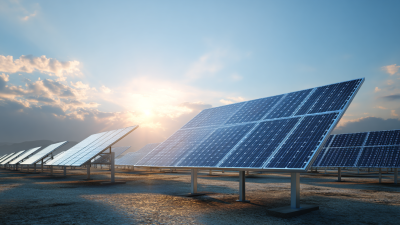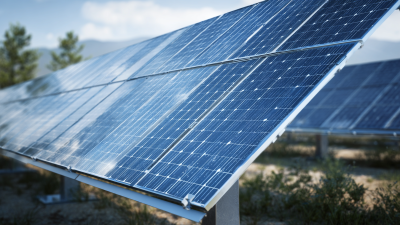Home Solar Panels: Common Challenges and Solutions for a Sustainable Future
As the global demand for renewable energy continues to rise, home solar panels have emerged as a pivotal solution for both homeowners and the environment. According to the U.S. Department of Energy, distributed solar photovoltaic (PV) systems can reduce electricity bills by an average of 50% over their lifespan, providing significant financial incentives. Moreover, a report from the International Energy Agency indicates that solar energy could account for up to 22% of global electricity generation by 2040, showcasing its potential in the transition to sustainable energy. However, despite their advantages, homeowners often face several challenges when adopting home solar panels, including high initial costs, space limitations, and regulatory hurdles. This blog will explore these common challenges and present practical solutions to help homeowners navigate the transition to solar energy effectively, ensuring a more sustainable future for generations to come.

Understanding the Basics of Home Solar Panels: Types and Technologies
Home solar panels have become an increasingly popular choice for homeowners seeking to harness renewable energy. At the core of this technology are different types of solar panels and their corresponding technologies. The most common types are monocrystalline, polycrystalline, and thin-film solar panels. Monocrystalline panels, known for their high efficiency and sleek design, typically convert around 15-20% of sunlight into usable energy. In comparison, polycrystalline panels, while slightly less efficient at approximately 13-16%, offer a more cost-effective solution. Thin-film panels, though less common, provide flexibility and lower initial costs, albeit with reduced efficiency levels.
When considering the switch to solar, understanding the various technologies can significantly impact your decision. For instance, bifacial solar panels, which can capture sunlight on both sides, are gaining traction and can increase energy yield by up to 20% in optimal conditions. It's also essential to consider the inverter type; string inverters are standard, while microinverters or power optimizers can enhance energy production and system monitoring.
Tips for choosing your solar panels:
1. Evaluate your energy needs and roof space to select the most appropriate type.
2. Research local incentives or rebates that may lower installation costs.
3. Always consult with a certified solar installer to assess the best technology tailored for your home’s unique requirements.

Common Challenges Homeowners Face When Installing Solar Panels
Homeowners often encounter a range of challenges when installing solar panels, particularly concerning costs and regulatory hurdles. Recent reports indicate that homeowners may face an additional €800 for specialized equipment designed to prevent disconnections in their solar photovoltaic systems. This unexpected expense can deter many from pursuing solar energy, especially when initial investments can already reach upwards of €10,000 for an average-sized house.
Permitting delays further complicate the solar installation process. In states like Colorado, homeowners are facing unnecessary challenges due to cumbersome permitting processes. This has led to frustrations particularly among those eager to transition to renewable energy. The increasing interest in alternatives such as balcony solar panel systems, particularly in Germany, highlights a growing trend where homeowners seek manageable solutions despite industry challenges. These units are emerging as an accessible entry point for many, indicating a shift in how homeowners can circumvent traditional barriers to solar energy adoption.
Moreover, low- and moderate-income households often grapple with unique obstacles. Even with local and state incentives in place, these groups face significant challenges in accessing solar energy. Studies show that without tailored programs addressing these barriers, the rate of solar adoption may stagnate, limiting progress toward a sustainable energy future.
Effective Solutions for Overcoming Solar Panel Installation Issues
Installing solar panels can transform your home into an eco-friendly powerhouse, but it’s not without its challenges. One common issue homeowners may face is the complexity of the installation process. Hiring a qualified professional is essential, as they can navigate local regulations and ensure that the system is correctly integrated into your home. Additionally, understanding the layout of your property and the potential for shading from trees or buildings can greatly impact the effectiveness of solar panels. Conducting a comprehensive site analysis before installation can help mitigate these concerns.

Another significant hurdle is the upfront cost associated with solar panel systems. Many homeowners are deterred by the initial investment, yet there are various financial options available. Government incentives, rebates, and financing plans can significantly reduce the initial burden. Furthermore, exploring community solar programs can enable individuals to invest in solar energy without bearing the full cost of installation. By embracing these solutions, homeowners can effectively address the challenges of solar panel installation and contribute to a sustainable future.
Maintaining Solar Panels: Tips for Long-Term Sustainability
Proper maintenance of solar panels is crucial for ensuring their longevity and optimal performance. Regular cleaning is the first step in this process. Dust, debris, and bird droppings can accumulate on the surface of solar panels, preventing sunlight from reaching the cells and reducing energy output. It's recommended to clean the panels with gentle soap and water or hire professionals who can safely handle the task, especially in hard-to-reach areas. Scheduling cleaning sessions at least twice a year can make a significant difference in maintaining efficiency.
In addition to cleaning, it's essential to periodically inspect the solar panel system for any signs of wear or damage. Checking for loose connections, cracks, or corrosion can help identify potential issues before they escalate into costly repairs. Moreover, keeping an eye on the performance metrics through your inverter can provide insights into how well your system is functioning. If you notice a sudden drop in energy production, it’s wise to consult a professional who can conduct a more thorough inspection. By staying proactive with both cleaning and inspections, homeowners can contribute to a sustainable future with their solar panel investments.
Home Solar Panels: Common Challenges and Solutions for a Sustainable Future - Maintaining Solar Panels: Tips for Long-Term Sustainability
| Challenge | Description | Solution | Frequency of Maintenance |
|---|---|---|---|
| Debris Accumulation | Leaves, dirt, and dust can reduce the efficiency of solar panels. | Regular cleaning with water or a soft brush. | Every 6 months |
| Panel Damage | Cracks or scratches can lead to reduced output. | Inspect panels regularly and replace damaged units. | Annually |
| Inverter Issues | Inverters can fail, affecting the entire system. | Choose high-quality inverters and consider replacement every 5-10 years. | Every 5 years |
| Shading Issues | Overhanging branches or buildings can cast shade on panels. | Trim branches and assess site for optimal solar exposure. | As needed |
| Wiring Issues | Frayed or loose wires can cause poor performance. | Regular inspections and professional wiring checks. | Annually |
The Importance of Government Incentives and Support for Solar Energy Adoption
Government incentives play a crucial role in accelerating the adoption of solar energy and addressing common challenges associated with home solar panels. Recent studies highlight that feed-in-tariff subsidies significantly boost investments in renewable energy firms by enhancing cash flow and alleviating financing constraints. This financial support not only encourages the installation of solar panels but also fosters innovation in photovoltaic technology, which is essential for achieving a sustainable future.
Tips for homeowners considering solar panels start with researching available local and federal incentives. These financial programs can greatly reduce upfront costs, making solar energy more accessible. Additionally, engaging with community organizations that advocate for renewable energy can provide valuable insights and resources. Homeowners should also remain informed about advancements in solar technology to maximize efficiency and return on investment. As demonstrated in countries like Ireland and Germany, government backing and public support can lead to significant increases in solar energy capacity and stronger commitments to sustainability.
Adoption of Solar Energy Over the Years in the USA
This chart illustrates the growth of installed solar capacity in gigawatts (GW) in the USA from 2015 to 2022. As seen, there is a significant upward trend, highlighting the increasing adoption of solar energy solutions over the years.
Related Posts
-

Harnessing 2025 Trends in Solar Technology to Choose the Best Solar Panels for Your Energy Needs
-

5 Essential Tips for Buyers to Maximize Benefits of Solar Hot Water Systems
-

Ultimate Guide to Harnessing Solar Thermal Energy for Your Home
-

Unlocking the Specifications of the Best Solar Solutions for Global Buyers
